
Hidden Spaces
By on Sep 06, 2007

With land costs and provincial policies resulting
in ever-shrinking building lots, builders and
homeowners are being forced to transformredundant areas of homes into usable living space. The
popular open-concept floor plan effectively eliminatedhallways and foyers that consumed viable living space.
And of course the previously maligned basement is now anintegral part of a home.
So how about all the crawlspace in the roof, traditionally
known as the attic? Although older homes continue to have their attics retrofitted, newer homes pose challenges
the industry may need to address.
Gabe Cicconi, president of Vesca Construction, says most
new home roof designs are not conducive to attic
renovations. "The pitch of the roof is imperative; if it'stoo low you simply do not have enough head room," he
says, adding that the attic's floor joists often are notengineered to support the weight of living space.
Then there's the small
problem of your new homewarranty program being voided
if structural modifications aremade. And even your home
insurance policy may beaffected.
So what would it take
for builders to make theirroofs attic-reno friendly? Lou
Frustaglio of DreamBuildersRenovations says it would
entail "designing the rooftrusses to be weight bearing,
adding some rough-in services,and providing an access point,"
noting it would only cost a fewthousand dollars if done at
the construction phase andadd as much as 25 per cent
more living space.
Indeed, innovative and
forward-thinking hombuilders
could easily achieve amarketing edge and greater
profits by re-evaluating howthey treat attic space.
With a little imagination,
today's crawlspace couldbecome a stunning walk-in
closet, a secret retreat off themaster bedroom, an inspiring
home office, a charming guestbedroom, a cozy playroom, a spacious loft, or a personal
theatre room. Or it could be used for something as mundaneas bare-bones storage space.
Depending on the level of rough-in during construction,
it might still be necessary for the homeowner to install
insulation, lay down flooring, put in drywall, and create astairway. And although heating and cooling could also be
accommodated and roughed-in using the home's original mechanical services, proven technologies used in placessuch as Europe also make it possible for the installation of
self-contained, stand-alone, ductless HVAC (heating,venting, and air conditioning) systems.

When converting your attic into living space, it's
important to be realistic about its dimensions.
Although it wouldn't take much to create thatstunning his-and-hers walk-in closet above the master
bedroom, it'll be a little morechallenging, if not impossible,
to create a billiards room.
That said, attic architecture
can present some very
interesting options. Theangles in the walls and
ceiling could be used asarchitectural features to
enhance the living space. Forexample, installing a plasma
TV screen on an angledceiling instead of a wall
means you can watch TVlying down and looking up.
And depending on how
you use paint and colour, aswell as the creative use of
skylights and windows, youcould create a visually stunning
striking environment.
Even access to the
attic presents intriguing
design opportunities. Homebuilders could extend the
principal stairway right upinto the attic, creating an
architectural centrepiecefor the home-and by
introducing a skylight,the home would also have
environmentally friendlynatural light.
Homeowners might consider the addition of creative
stairways: everything from the hideaway fold-out styleto artistically striking stairways with concealed wall
brackets that create the illusion that the stairs aresuspended in space.
Indeed, the attic is poised to easily come back into
vogue. All it would take is for homeowners to startasking builders to add them.


